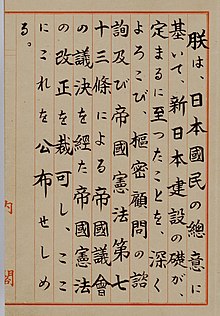Ji̍t-pún-kok Hiàn-hoat
(Tùi Ji̍t-pún hiàn-huat choán--lâi)
Ji̍t-pún-kok Hiàn-hoat (日本國憲法) sī Ji̍t-pún ê hiān-hêng hiàn-hoat, mā hō-chò Chiàn-āu Hiàn-hoat (戰後憲法), Hô-pêng Hiàn-hoat (和平憲法), Chiau-hô Hiàn-hoat (昭和憲法), tī 1946 nî 11 goe̍h 3 hō kong-pò͘, 1947 nî 5 goe̍h 3 hō khí si-hêng. Che sī Ji̍t-pún-kok Chèng-hú tī 1945 nî tâu-hâng liáu-āu chè-tēng lâi chhú-tāi Tāi Ji̍t-pún Tè-kok Hiàn-hoat ê sin hiàn-hoat.
| Ji̍t-pún-kok hiàn-hoat | |
|---|---|
 Ji̍t-pún-kok Hiàn-hoat sū-giân | |
| Overview | |
| Original title | 日本国憲法 |
| Jurisdiction | Japan |
| Date effective | 3 May 1947 |
| System |
Unitary parliamentary de facto[1] constitutional monarchy |
| Government structure | |
| Branches | Three |
| Goân-siú | Not defined in constitution.[2] The Emperor is "the symbol of the State and of the unity of the people", but carries many functions of a head of state.[1] |
| Li̍p-hoat ki-koan | Bicameral (National Diet: House of Representatives, House of Councillors) |
| Hêng-chèng ki-koan | Cabinet, led by a Prime Minister |
| Su-hoat ki-koan | Supreme Court |
| Federalism | Unitary |
| Electoral college | No |
| Le̍k-sú | |
| First legislature |
20 April 1947 (HC) 25 April 1947 (HR) |
| First executive | 24 May 1947 |
| First court | 4 August 1947 |
| Amendments | 0[3] |
| Location | National Archives of Japan |
| Author(s) | Allied GHQ and members of the Imperial Diet |
| Signatories | Emperor Shōwa |
| Supersedes | Meiji Constitution |
| Full text | |
|
| |
Tsù-kái
siu-kái- ↑ 1.0 1.1 Kristof, Nicholas D. (12 November 1995). "THE WORLD;Japan's State Symbols: Now You See Them . ." The New York Times. 5 October 2019 khòaⁿ--ê.
- ↑ Kakinohana, Hōjun (23 September 2013). "個人の尊厳は憲法の基 ― 天皇の元首化は時代に逆行 ―". Japan Institute of Constitutional Law (ēng Ji̍t-pún-gí). goân-loē-iông tī 2019-10-25 hőng khó͘-pih. 2019-10-25 khòaⁿ--ê.
- ↑ "The Anomalous Life of the Japanese Constitution". Nippon.com. 15 August 2017. goân-loē-iông tī 11 August 2019 hőng khó͘-pih. 11 August 2019 khòaⁿ--ê.